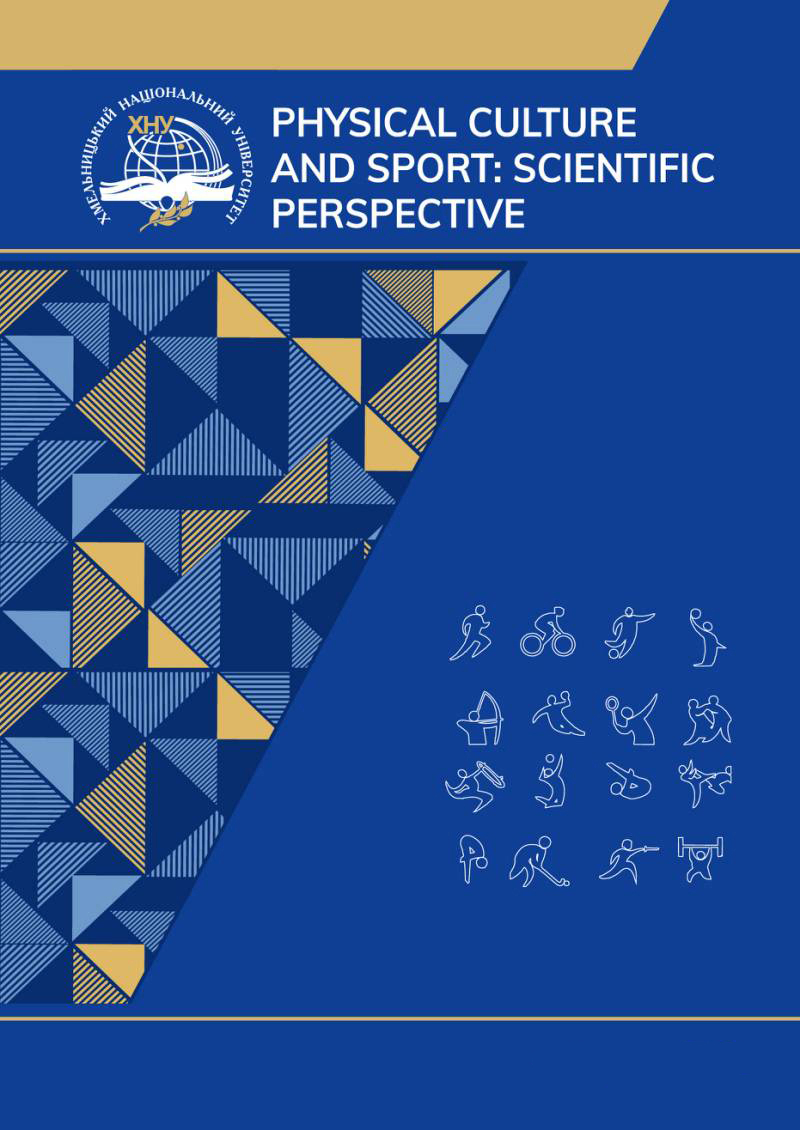ЗАКОРДОННИЙ ДОСВІД ВИКОРИСТАННЯ ІНФОРМАЦІЙНИХ ТЕХНОЛОГІЙ У ФІЗИЧНОМУ ВИХОВАННІ, СПОРТІ ТА ФІТНЕСІ
DOI:
https://doi.org/10.31891/pcs.2024.2.10Ключові слова:
інформаційні технології, комп’ютерні програми, мобільні додатки, фізичне виховання, спорт, фітнесАнотація
У статті розглядається міжнародний досвід використання інформаційних технологій у фізичному вихованні, спорті та фітнесі. Дослідження аналізує різні програмні продукти та мобільні додатки, які широко використовуються в цих сферах у різних країнах. Дослідження висвітлює кілька ключових категорій технологічних застосувань, включаючи інформаційно-діагностичні системи, інструменти оцінки функціональної пристосованості, програмне забезпечення для біомеханічного аналізу та програми для здоров’я та фітнесу. У статті обговорюються відомі приклади, такі як FitnessGram, Канадська оцінка фізичної грамотності (CAPL), тест ALPHA-FIT і Модель фізичного розвитку молоді. У сфері спорту в статті розглядаються професійні системи біомеханічного аналізу, такі як SIMI Motion і Qualisys Track Manager, а також більш доступні варіанти, такі як Dartfish і Kinovea. Дослідження також вивчає такі популярні фітнес-додатки, як MyFitnessPal, Strava та Nike Training Club, обговорюючи їхні особливості та вплив на фізичну активність і управління здоров’ям.
Посилання
Balsalobre-Fernandez, C., Tejero-Gonzalez, C.M., del Campo-Vecino, J., & Bavaresco, N. (2014). The concurrent validity and reliability of a low-cost, high-speed camera-based method for measuring the flight time of vertical jumps. Journal of Strength and Conditioning Research, 28(2), 528–533.
Blanchard, J., Van Wyk, N., Ertel, E., Alpous, A., & Longmuir, P. E. (2019). Canadian Assessment of Physical Literacy in grades 7-9 (12-16 years): Preliminary validity and descriptive results. Journal of Sports Sciences, 38(2), 177–186. https://doi.org/10.1080/02640414.2019.1689076
Casey, A., & Jones, B. (2011). Using digital technology to enhance student engagement in physical education. Asia-Pacific Journal of Health, Sport and Physical Education, 2(2), 51-66.
Damian, J., Rivers. (2020). Strava as a discursive field of practice: Technological affordances and mediated cycling motivations. Discourse, Context & Media, 34, April. DOI: 10.1016/j.dcm.2019.100345.
Daniel, R., & Bangun, C. (2022). Strava: participatory culture and community engagement of rocc members. Jurnal Komunikasi Profesional, 6, 1-15. DOI: 10.25139/jkp.v6i1.4324
Domin, A., Ouzzahra, Y., & Vögele, C. (2022). Features and Components Preferred by Adolescents in Smartphone Apps for the Promotion of Physical Activity: Focus Group Study. JMIR Human Factors, 9(2), e33972. https://humanfactors.jmir.org/2022/2/e33972. DOI: 10.2196/33972.
Ganguly, A., Rashidi, G., & Mombaur, K. (2021). Comparison of the Performance of the Leap Motion ControllerTM with a Standard Marker-Based Motion Capture System. Sensors, 3, 1750.
Krishnan, C., Washabaugh, E.P., & Seetharaman, Y. (2015). A low cost real-time motion tracking approach using webcam technology. Journal of Biomechanics, 48(3), 544–548. pmid:25555306.
Kretschmann, R. (2015). Physical education teachers’ subjective theories about integrating information and communication technology (ICT) into physical education. Turkish Online Journal of Educational Technology, 14, 68-96.
Lu, Z., Nazari, G., MacDermid, J.C., Modarresi, S., & Killip, S. (2020). Measurement Properties of a 2-Dimensional Movement Analysis System: A Systematic Review and Meta-analysis. Archives of Physical Medicine and Rehabilitation, 101(9), 1603-1627. DOI: 10.1016/j.apmr.2020.02.011.
Macleod, C.A., Conway, B.A., Allan, D.B., & Galen, S.S. (2014). Development and validation of a low-cost, portable and wireless gait assessment tool. Medical Engineering and Physics, 36(4), 541–546. pmid:24345892.
Meckbach, J., Gibbs, B., Almqvist, J., Öhman, M., & Quennerstedt, M. (2013). Exergames as a Teaching Tool in Physical Education?. Sport Science Review, 12, 369-385. DOI: 10.2478/ssr-2013-0018.
Ortega, F.B., Leskošek, B., Blagus, R., et al. (2023). European fitness landscape for children and adolescents: updated reference values, fitness maps and country rankings based on nearly 8 million test results from 34 countries gathered by the FitBack network. British Journal of Sports Medicine, 57, 299-310.
Pagoto, S., Schneider, K.L., Evans, M., Waring, M.E., Appelhans, B., Busch, A.M., Whited, M.C., Thind, H., & Ziedonis, M. (2014). Tweeting it off: characteristics of adults who tweet about a weight loss attempt. Journal of the American Medical Informatics Association, 21(6), 1032-1037. DOI: 10.1136/amiajnl-2014-002652. PMID: 24928175; PMCID: PMC4215051.
Pennington, C. (2023). Using FitnessGram to Measure the Impact of 'Lost' Physical Education During the COVID Years. International Journal of Physical Education Fitness and Sports, 12, 59-68. DOI: 10.54392/ijpefs2336.
Plowman, S.A. (2013). Muscular Strength, Endurance, and Flexibility Assessments. In S. A. Plowman & M.D. Meredith (Eds.), Fitnessgram/Activitygram Reference Guide (4th Edition) (pp. 8-1 - 8-55). Dallas, TX: The Cooper Institute.
Pluim, C., & Gard, M. (2018). Physical education’s grand convergence: Fitnessgram®, big-data and the digital commerce of children’s health. Critical Studies in Education, 59(3), 261-278. https://doi.org/10.1080/17508487.2016.1194303.
Puig-Diví A, Escalona-Marfil C, Padullés-Riu JM, Busquets A, Padullés-Chando X, et al. (2019) Validity and reliability of the Kinovea program in obtaining angles and distances using coordinates in 4 perspectives. PLOS ONE 14(6): e0216448. https://doi.org/10.1371/journal.pone.0216448
Roy, G., Jacob, T., Bhatia, D., Bhaumik, S. (2020). Optical Marker- and Vision-Based Human Gait Biomechanical Analysis. In: Bhattacharyya, S., Konar, D., Platos, J., Kar, C., Sharma, K. (eds) Hybrid Machine Intelligence for Medical Image Analysis. Studies in Computational Intelligence, vol 841. Springer, Singapore. https://doi.org/10.1007/978-981-13-8930-6_11
Subasinghe, A., Garland, S., Gorelik, A., Tay, I., & Wark, J. (2019). Using Mobile Technology to Improve Bone-Related Lifestyle Risk Factors in Young Women With Low Bone Mineral Density: Feasibility Randomized Controlled Trial. JMIR Formative Research, 3(1), e9435. https://formative.jmir.org/2019/1/e9435. DOI: 10.2196/formative.9435.
Thewlis, D., Bishop, C., Daniell, N., & Paul, G. (2013). Next-generation low-cost motion capture systems can provide comparable spatial accuracy to high-end systems. Journal of Applied Biomechanics, 29(1), 112–117. https://doi.org/10.1371/journal.pone.0216448.
van de Glind, I., Bunn, C., Gray, C.M., Hunt, K., Andersen, E., Jelsma, J., Morgan, H., Pereira, H., Roberts, G., Rooksby, J., et al. (2017). The intervention process in the European Fans in Training (EuroFIT) trial: a mixed method protocol for evaluation. Trials, 18(1), 356.
Dr Rhodri Lloyd. The Youth Physical Development Model version 2.0. IronMan Performance. URL: [https://joeeisenmann.substack.com/p/understanding-youth-athlete-development](https://joeeisenmann.substack.com/p/understanding-youth-athlete-development).
Welk, G.J., Going, S.B., Morrow Jr., J.R., & Meredith, M.D. (2011). Development of New Criterion-Referenced Fitness Standards in the FITNESSGRAM® Program: Rationale and Conceptual Overview. American Journal of Preventive Medicine, 41(4), S63-S67. DOI: 10.1016/j.amepre.2011.07.012.





